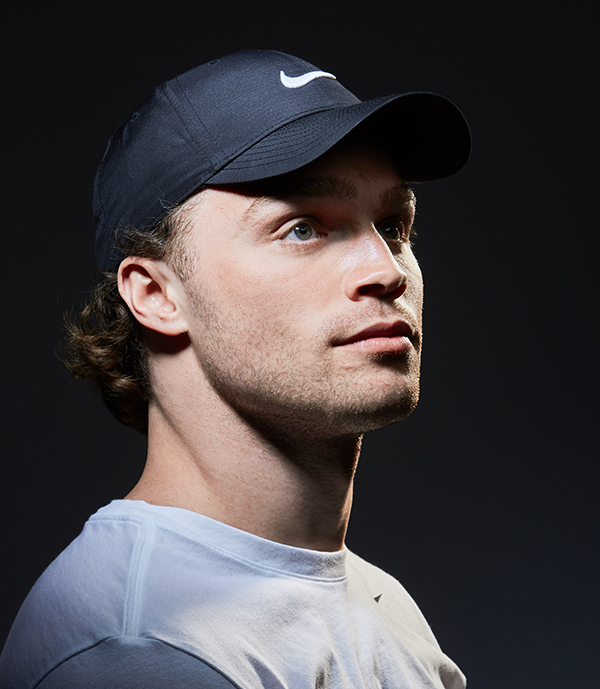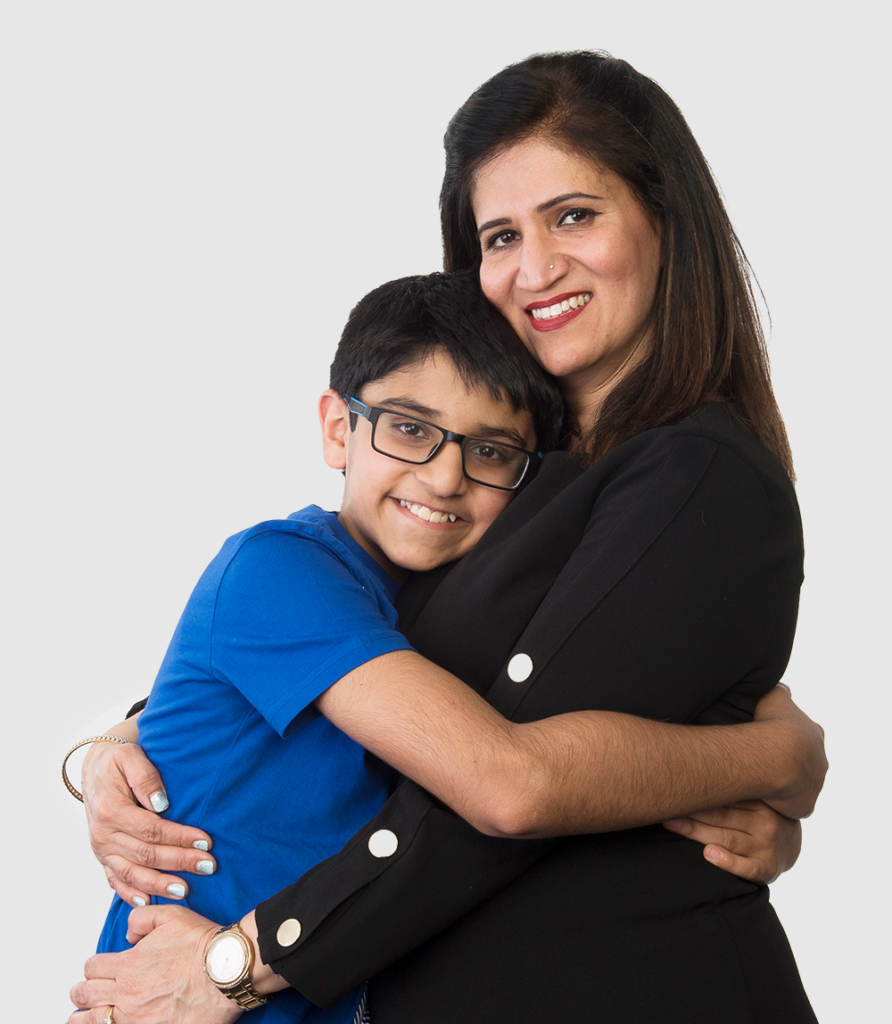
Our Community
We are very fortunate to have such a passionate and dedicated type 1 diabetes (T1D) community – a community that supports each other and does everything they can to improve the lives of those living with T1D.
Lorne Shiff
Diagnosed at age 7
Former JDRF Board Chair
In the past 50 years since I was diagnosed, the world for those living with T1D has changed enormously. I want to acknowledge my parents; Helaine and Allan Shiff, who were determined to find a CURE for T1D when I was diagnosed. My mother who worked tirelessly as one of the founding volunteer members of JDRF Canada until her passing just recently.
The world would not be as it is today without JDRF, which marks its 50th year as well. My story is in large part the story of JDRF and the thousands of incredible volunteers and staff who have brought us to where we are today.
When I was diagnosed there was one type of insulin called ‘regular’, which you took once a day by injection with a syringe and needle, and had to be sterilized each time after use. I could only estimate my blood sugar levels, as there was not yet blood glucose testing. I now use an insulin pump with rapid acting insulin. JDRF has and continues to change the way we are improving the lives of all those living with T1D.
But – living with T1D is very difficult. And unless you live with T1D you do not understand how very difficult life truly is. It is a 24 hour a day 365 days a year burden. The psychological impact of this disease can not be underestimated for both me and my family. So, that is why I have dedicated a good portion of my life to helping JDRF move our mission forward.
JDRF leads the world in T1D research and we need to accelerate our accelerate the pace of our research to get to closer to our goal of a world without diabetes.
I truly believe that this is an achievable goal. For me, a world without diabetes would mean a number of things. But top among them would be never again having to worry that my children with have to live with T1D. That would mean everything.
Kristen Garland
Diagnosed at age 26
Mother of a child living with T1D
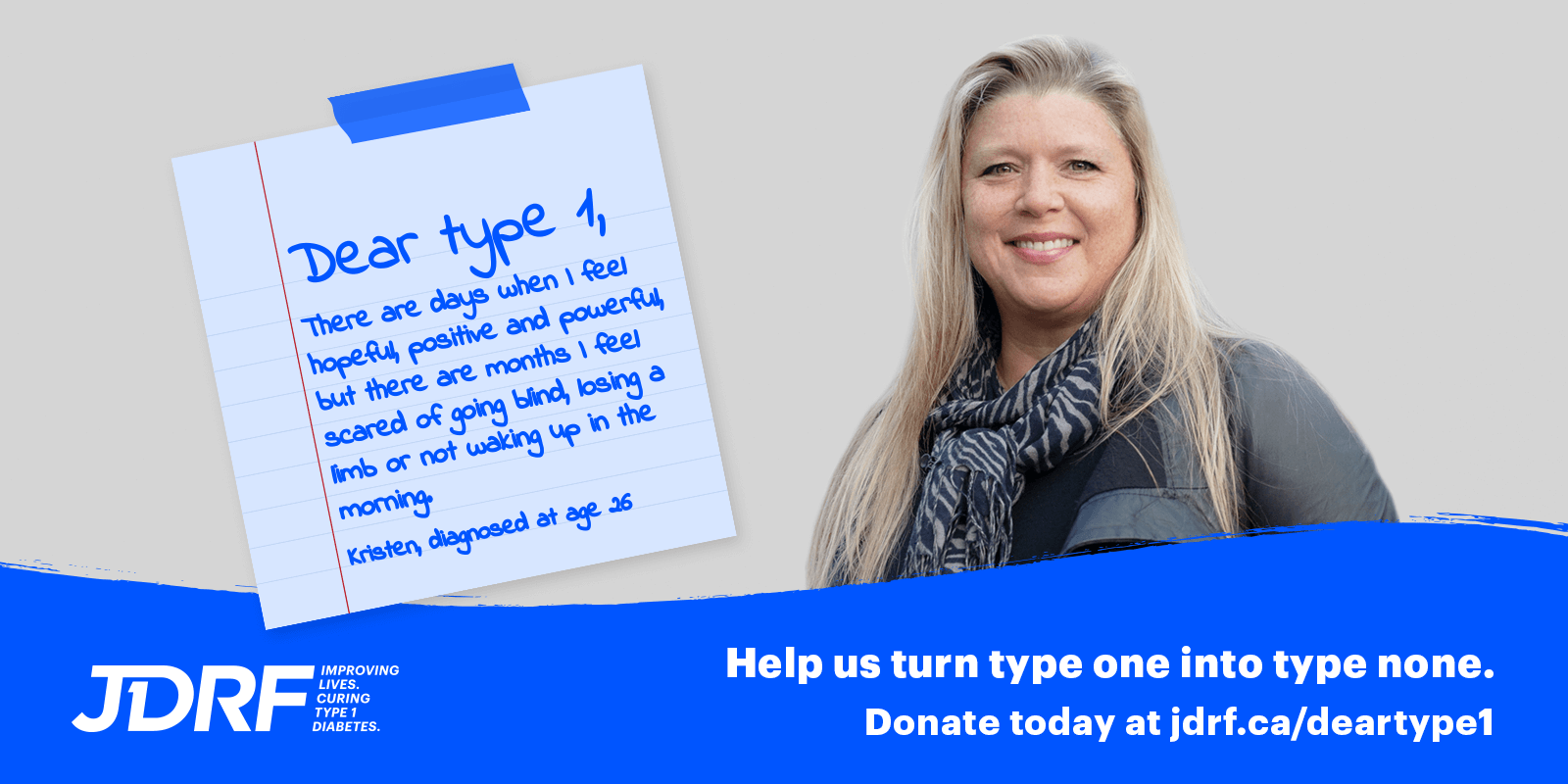
At diagnosis, I was a mom with a young child, which meant I was very familiar with the constant tug of a toddler needing your attention. Looking back, having T1D was similar to that experience in that it is always there, always interrupting, always needing you to do something, check something, eat something, but there’s no adorable face, melt-your-heart smile or warm fuzzy hug attached. Now, it’s about reconciling the fact that it took my fragile, innocent, brave, resilient child being attacked by this monster to inspire and finally motivate me to take better care of myself for her sake, if for nothing else. To be a role model for good management, so that she follows your example and lives a long, healthy, full life. In a strange twist of fate, she has saved my life.
Kenadie
Diagnosed at age 7
I don’t really remember a life without diabetes. I remember when I got to the hospital and the doctors told me I had type 1 diabetes, I was happy, because it meant I was just like my mom (who has T1D). She calls us blood sugar buddies.
As I get older, it gets in the way a lot more. I hate waking up to treat low blood sugars in the middle of the night or feeling dizzy, nauseous and sick when my site fails and my blood sugars skyrocket.
I have been able to do some cool things because I have T1D though, like go to Camp Huronda, meet Nick Jonas, go to Ottawa and speak to politicians, co-emcee galas and be an ambassador for JDRF. I’ve met a lot of great people and had fun at all the fundraisers…but I’d trade all that in a second for a cure.
Myrzah
Mother of a child with T1D
T1D has significantly changed my life as a parent. I constantly worry about the health of my daughter far more than before the diagnosis. I have more knowledge about the human body and nutrition values of food.
I feel I had to become T1D nurse overnight and become part of her support system. It is very important to have a good support system of family and friends.
People have the perception that after the diagnosis and consulting the medical team, T1D is under control. They don’t understand that it’s a daily task to maintain control. We need to accelerate the pace of T1D to give a better life quality to the people living with T1D and potentially avoid future diagnoses.
For me a cure would mean that my daughter wouldn’t have to worry about her blood sugar levels 24h/7. She could be out with her friends without having to think about her level of activity and what she is eating etc. And of course I would worry much less when she goes out with her friends.
My message to other parents of newly diagnosed T1D children is after the shock of the diagnosis and the overwhelming time of learning everything, it is important to accept that this condition is now part of your child’s life and family. Acceptance is key to keep going, especially on the days where we are completely discouraged.
Caleah
Diagnosed at age 8
Since my diagnosis, I have to constantly check my blood sugar levels, take note of what I eat and count carbs. I have to take care that I am not too high or too low. It is something I constantly have to take care of.
I want people to know that it’s not because I eat too much sugar or have poor health habits that I have T1D. On the contrary, we can’t prevent getting a T1D diagnosis. Our pancreas ceases to produce insulin.
Having better research and progress into T1D would facilitate our lives. And a cure would mean freedom and peace of mind. No more checking blood sugars, carb counting or worrying about my blood levels.
Having T1D does not prevent you from following your dreams. You can do whatever you want as long as you manage your T1D properly.
Ashit Dattani
Father of a child with T1D
My son Samir was just 8 years old when he was diagnosed with T1D. At that age they are still young, but they are starting to be a bit more independent. They can get snacks, play in the backyard with friends and just be carefree kids. That all changed on December 10th, 2010. We became intimately involved with every aspect of his life – what did he eat, what is he playing, where is he, what are his blood sugar numbers, how much insulin does he have on board? He went from being this carefree little boy to having to become careful with everything he did.
T1D means a 24 hour a day matrix of decisions that is always on your mind – when you’re at work, at school, heading to the gym, enjoying a meal with friends, or even going to sleep – it never stops.
This disease has an incredible impact on individuals, families, the economy and the healthcare system. Even though Samir is 18 today and living on his own at McGill, we still think about his diabetes every day. T1D doesn’t impact one person. It affects parents, grandparents, siblings. extended family and friends.
We need to come together to put an end to type 1 diabetes.
Fanny Guimont-Desrochers, PhD, SCYM
Immunology Research Scientist
Diagnosed at age 5
I was diagnosed with T1D when I was 5 years old. It immediately turned my life upside down. I had to prick my fingers and inject insulin multiple times a day. One could think that the injections were the worst part, but the management of the disease was way harder.
Living with T1D is like wondering at every moment of your life if your body will fail you, either because of low blood glucose level (which can cause coma if not treated), high blood glucose level or long term T1D-related complications (such as blindness, heart attack, kidney damage). This is also why I became a research scientist to help advance the cause of a T1D cure.
We need to accelerate the pace of T1D research because we are standing at a crossroads. Many promising innovations are close to becoming reality, and we need to make them available to all those who need it.
New fields of research are opening and hinting at promising potential therapies or cures that we never thought possible. Better treatments and even a cure for T1D have never been at a closer reach than they are today.
Recently, I had two safe pregnancies (without dangerous hypoglycemia) and perfectly healthy babies. Living with T1D is still a challenge I have had to live with every moment of every day for the past 30 years. That is why I am so committed to work with JDRF to cure diabetes
Helping JDRF find a cure for T1D will prevent kids other from losing their childhood. A 5-year-old kid should think about playing with his friends, not his next insulin injection. We have extremely talented scientists working on better treatments and cures. They need our help.
Lauren Bongiorno
Health coach, diagnosed at age 7
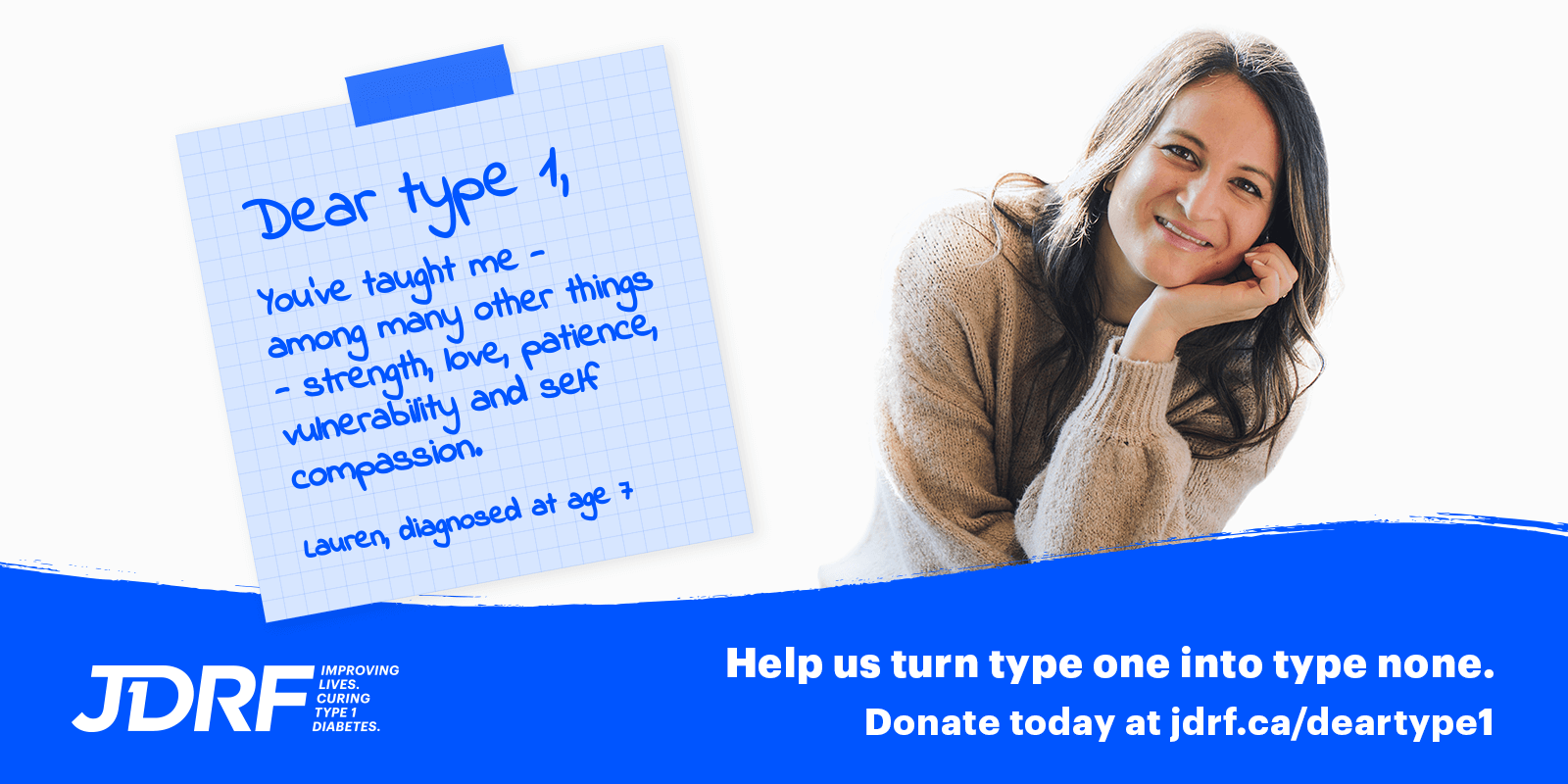
Dear type 1,
This month is our 20 year anniversary together. And 20 years ago, me and my family definitely thought we’d be divorced by now. We kept hearing that a cure for you was “right around the corner”, always just “5 years away”, but it never came. You’d think that would make me upset, but I’m not. I’m okay that we’re still together. You’ve been this thread that has run through every part of my life: my first sleep over, soccer games, family vacations, school concerts, prom, tests, college, the moment I got engaged… And through it all I have gratitude for all you’ve taught me.
Strength.
Resilience.
Self compassion.
Love.
Patience.
The value of health.
Vulnerability.
Community.
Trust.
Imperfection.
Self awareness.
Self efficacy.
…how your health goes beyond the numbers your dexcom shows and is about how you feel from day to day mind and body. You taught me that. So while I know life may have been a bit easier without you in it, I also know we were meant to be together. I accept you. I appreciate you. I love you.
P.S I’d love if we could go on another honeymoon together sometime. That was the best 8 months ever. Let’s set something up shall we?
Dr. Mike Riddell
Type 1 diabetes researcher
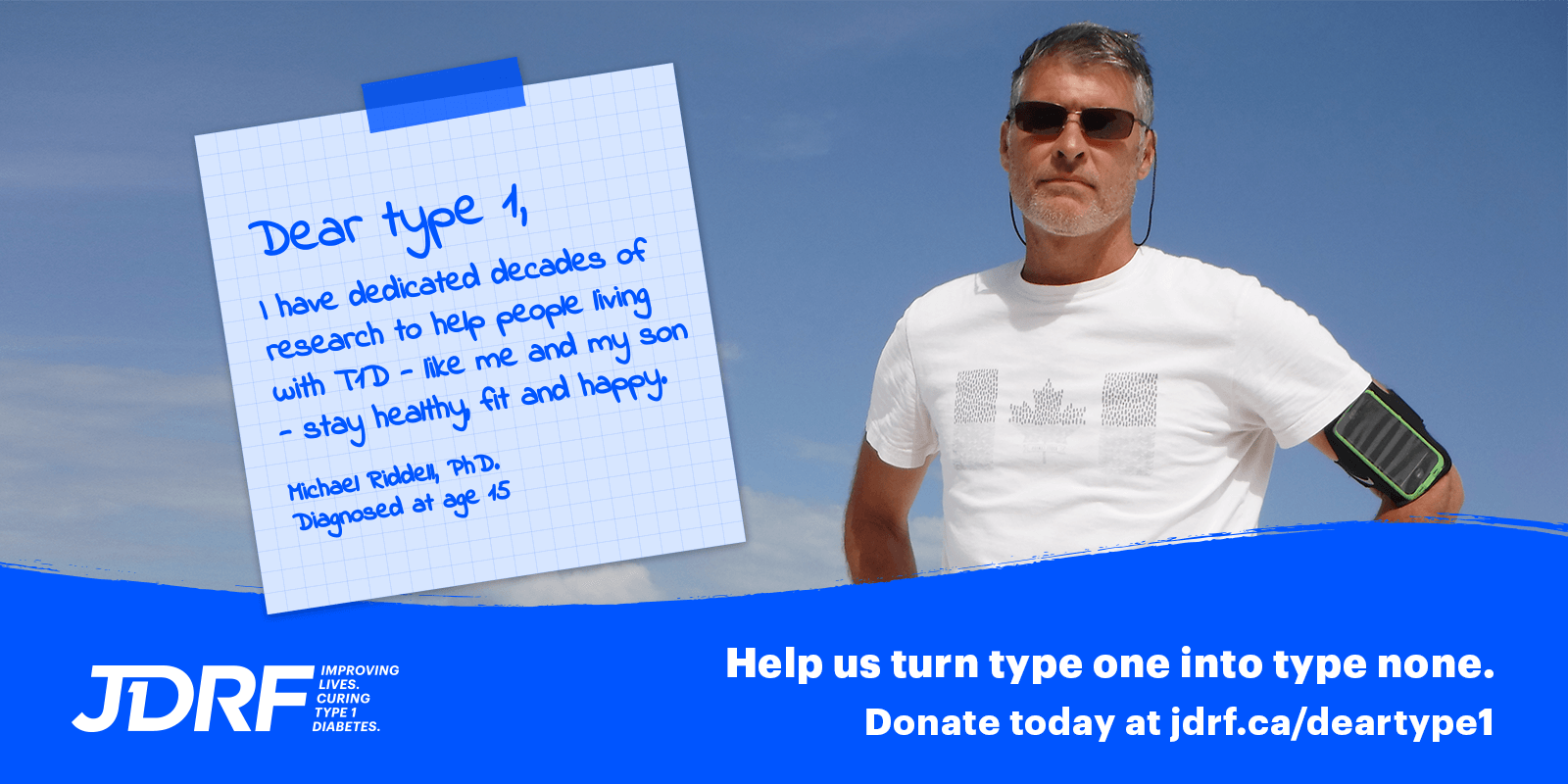
Since my own diagnosis at age 15, I have dedicated much of my energy into learning as much as possible about how various factors like exercise, food and stress influence blood glucose levels in diabetes.
After my son’s diagnosis 4 years ago, I have thought more about the burden that type 1 diabetes can bring to families. In spite of the challenges we face, type 1 diabetes has connected us in many special ways. I have made it my life mission to learn as much as possible so that I can help others living with type 1 diabetes be as healthy, fit and happy through the sharing of our various success and challenges.
Living with type 1 diabetes requires numerous daily decision-making actions that impact the way we feel, function and thrive. Being regularly physically active with type 1 diabetes is as important as all the other things we need to think about (glucose testing, taking insulin, eating nutritious foods, managing stress, and looking after our bodies and mind).
My team of researchers are discovering how a person living with type 1 diabetes can best manage their own blood sugar levels while leading an active lifestyle. Using insulin pumps, glucose sensing technologies, new types of insulin and other medications, we hope to keep as many people living with type 1 diabetes reach their own personal athletic goals and dreams, weather it’s to compete at the Olympic Games or be on a primary school’s hockey roster. We are also testing a brand new therapeutic that should help people with type 1 diabetes not develop hypoglycemia as frequently when they exercise, don’t eat enough food or take too much insulin.
The discovery of insulin 100 years ago has kept us alive with this disease. Now we need to take action so that we can live a near normal life by using new technologies while we accelerate our focus on finding a cure for the next generation.
A cure would mean that me, my friends, my son and all the rest of us would no longer live the burden of managing this disease. But I do take pride in being part of a very special community of individuals with type 1 diabetes who have accomplished so much for each other. From running across Canada, or climbing Everest to playing in the NHL to being an actor or pop star- incredible things have been done by people who have something special in common with me.
We all face challenges every single day, no matter who you are. It’s how you face them that shows the character of your being.
Priye Iworima
Type 1 diabetes researcher
Our research uses stem cells to generate insulin-producing cells that we hope are similar to the beta cells found in your body. We hope that these cells can be used for cell replacement therapy one day, so the body produces its own insulin again.
T1D research has the potential to improve the quality of life for anyone who has or is affected by someone with diabetes. Many fantastic researchers are working on making this dream of stem cell-derived insulin-producing cells a reality for patients. It’s a fantastic time to be involved in this research.
A cure would mean freedom. Freedom from having to monitor your blood glucose levels constantly. Freedom from any anxieties anyone has. Freedom to achieve all your wildest dreams!
Science is excellent, but the people in the T1D community continue to inspire and motivate me. I am grateful to all of you.

